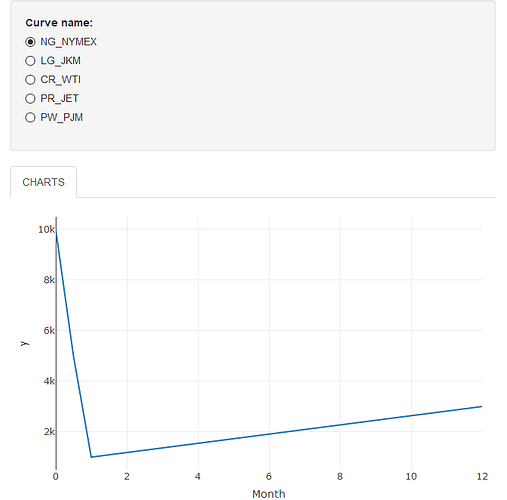Hello PJ,
Thank you for this. It helped me advance. I fear I did not provide enough of my code to allow you to offer the complete solution to my problem, apologies. So I still get an error message when the routine tries to plot: ".y must be a vector, not a reactiveExpr/reactive/function object". Here is the full code.
#
# v 1.0 mb 042921
# VaR_Scenario_Analysis_R_Code.R
#
# R Code to illustrate Interface for VaR Scenario Analysis Tool
#
library(shiny)
library(plotly)
library(purrr)
#z_curve <- "NG_NYMEX"
z_curves_expos_delta <-
data.frame(
Tenor = c("SPOT", "BALM", "PRPT", "1_YR"),
Month = c(0, 0.5, 1, 12),
NG_NYMEX = c(10000, 5000, 1000, 3000),
LG_JKM = c(1000, 7000, 1000, 4000),
CR_WTI = c(8000, 4000, 2500, 1000),
PR_JET = c(6000, 3000, 4500, 2000),
PW_PJM = c(9000, 7000, 4500, 2000)
)
ui <- fluidPage(
titlePanel("POC for Interface - QP VaR Scenario Analysis - CRMS in Shell T&S"),
textOutput("a_curve"),
textOutput("selected_var"),
sidebarLayout(
sidebarPanel(
# Input: Select the random distribution type ----
radioButtons(
"curve",
"Curve name:",
c(
"NG_NYMEX" = "NG_NYMEX",
"LG_JKM" = "LG_JKM",
"CR_WTI" = "CR_WTI",
"PR_JET" = "PR_JET",
"PW_PJM" = "PW_PJM"
),
selected = "NG_NYMEX"
),
radioButtons(
"ad-hoc_scenario",
"Ad-Hoc Scenario:",
c(
"Target levels specified by drawing in chart" = "chart",
"Target levels specified by typing in table" = "table"
)
),
radioButtons(
"date-range_scenario",
"Date Range Scenario:",
c("Target levels based on changes between 2 past dates" = "past_dates")
),
dateRangeInput("daterange1", "Date range:",
start = "2001-01-01",
end = "2021-04-28"),
radioButtons(
"preset_scenario",
"Preset Scenario:",
c(
"Polar Vortex 2021" = "preset_Vortex-2021",
"Hurricane Harvey" = "preset_Harvey",
"Gulf War" = "preset_Gulf"
)
),
),
mainPanel(tabsetPanel(
type = "tabs",
tabPanel(
"CHARTS",
fluidRow(
column(4, plotlyOutput("p_expoD"))
)
),
tabPanel(
"TABLES",
fluidRow(
column(4, tableOutput("table_expoD"))
)
),
tabPanel("CORRELATIONS")
))
)
,
tags$head(tags$style(
HTML('* {font-family: "Arial"; font-size: 12px;};')
))
)
server <- function(input, output, session) {
####################### CURVE NAME SELECTION - START #######################
#
# Code works if I set "z_curve" specifically like in line below but not if set via Radio Button as Reactive Value
# z_curve <- "NG_NYMEX"
zz_curve <- reactive({
input$curve
})
output$a_curve <- renderText({
paste("You chose", zz_curve())
})
#Reactive dataframe based off input selection
z_exposD <-
reactive({
tmp <- z_curves_expos_delta %>% select(input$curve)
return(tmp)
})
####################### CURVE NAME SELECTION - END #######################
####################### CURVE DATA SELECTION - START #######################
# Code works if I set "z_exposD" specifically like in line below but not if set it via Radio Button as Reactive Value
#z_exposD <- z_curves_expos_delta[, z_curve]
z_tenors <- z_curves_expos_delta$Tenor
z_months <- z_curves_expos_delta$Month
####################### CURVE DATA SELECTION - END #######################
####################### EXPOSURES DELTA - START #######################
rv_expoD <- reactiveValues(x = z_months,
y = z_exposD)
grid_expoD <- reactive({
data.frame(x = seq(min(rv_expoD$x), max(rv_expoD$x), length = 10))
})
# model_expoD <- reactive({
# d <- data.frame(x = rv_expoD$x, y = rv_expoD$y)
# loess(y ~ x, d)
# })
output$p_expoD <- renderPlotly({
# creates a list of circle shapes from x/y data
circles <- map2(
rv_expoD$x,
rv_expoD$y,
~ list(
type = "circle",
# anchor circles at (mpg, wt)
xanchor = .x,
yanchor = .y,
# give each circle a 2 pixel diameter
x0 = -4,
x1 = 4,
y0 = -4,
y1 = 4,
xsizemode = "pixel",
ysizemode = "pixel",
# other visual properties
fillcolor = "blue",
line = list(color = "transparent")
)
)
fig <- plot_ly(source = "fig_expoD") %>%
add_markers(
x = z_months,
y = z_exposD,
color = I("green"),
name = "exposures Delta"
)
# fig <- fig %>% add_lines(x = grid()$x, y = predict(loess(y ~ x, data.frame(x = z_months, y = z_exposD) ), grid()), color = I("green"), name = "original")
# fig <- fig %>% add_trace(x = grid()$x, y = predict(model(), grid()), color = I("red"), mode = "markers+lines", name = "scenario")
fig <-
fig %>% add_bars(
x = rv_expoD$x,
y = rv_expoD$y,
color = I("red"),
mode = "markers+bars",
name = "scenario"
)
fig <-
fig %>% add_bars(
x = z_months,
y = z_exposD,
color = I("green"),
name = "originals"
)
fig <-
fig %>% layout(shapes = circles) %>% config(edits = list(shapePosition = TRUE))
fig
})
data_expoD <- reactive({
d <-
data.frame(Deltas = rv_expoD$x,
Original = z_exposD,
Scenario = rv_expoD$y)
d
})
output$table_expoD <- renderTable({
data_expoD()
})
# update x/y reactive values in response to changes in shape anchors
observe({
ed <- event_data("plotly_relayout", source = "fig_expoD")
shape_anchors <- ed[grepl("^shapes.*anchor$", names(ed))]
if (length(shape_anchors) != 2)
return()
row_index <-
unique(readr::parse_number(names(shape_anchors)) + 1)
pts <- as.numeric(shape_anchors)
rv_expoD$x[row_index] <- pts[1]
rv_expoD$y[row_index] <- pts[2]
})
####################### EXPOSURES DELTA - END #######################
}
shinyApp(ui, server)

